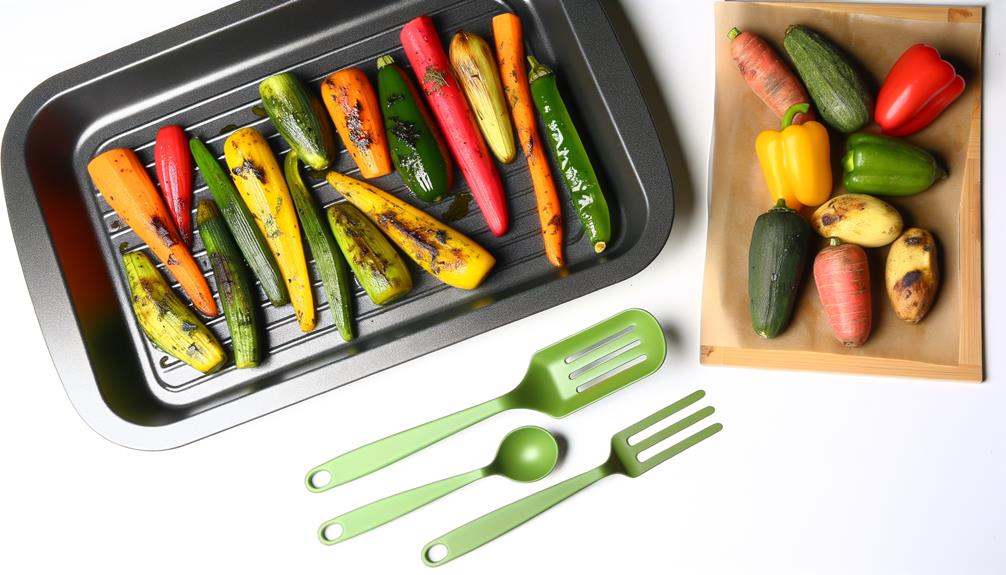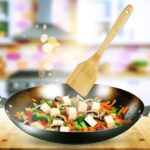Isn’t it grand how the simple act of roasting can transform humble vegetables into a culinary masterpiece? You, my friend, are about to embark on a flavorful journey that will let you in on the secrets of roasting vegetables the vegan way. We’ll talk about the essential tools, the right oils, the tantalizing seasonings, and the perfect roasting temperatures. We’ll even give you a few bonus tips on storing and reheating your roasted delights. There’s so much to explore, so let’s get started, shall we? But remember, patience is a virtue, especially when waiting for those deliciously caramelized edges.
Key Takeaways
- Choose hearty vegetables like potatoes, carrots, brussels sprouts, bell peppers, beets, and zucchini for roasting.
- Wash and pat dry vegetables to remove dirt and pesticides before cutting them into uniform pieces for even cooking.
- Toss the vegetables in a large bowl with oil, salt, and pepper for an even coating, then arrange them on a baking sheet lined with parchment or a silicone mat.
- Experiment with different oils and seasonings to add flavor and variety to your roasted vegetables.
Choosing the Right Vegetables
Before you even preheat the oven, choosing the right mix of vegetables is crucial to roasting success. You need to deliberate over your veggie selections like a seasoned sommelier choosing the perfect wine.
Consider hearty vegetables like potatoes and carrots. They’re the robust, trusty comrades your roasting pan needs. They take longer to cook, but their flavors deepen and intensify, making them worth the wait. Add in some brussels sprouts for a touch of green and a peppery kick. They’ll transform under the heat, their outer leaves crisping to a delicious crunch.
Don’t shy away from playing with colors and textures. Roasting isn’t just about taste; it’s a feast for the eyes too. Think vibrant bell peppers, earthy beets, and tender zucchini. They’ll add a splash of color and a variety of textures to your dish.
Seasonal vegetables are always a brilliant choice. They’re fresh, flavorful, and full of the goodness that Mother Nature intended.
Your mission when choosing the right vegetables is to ensure even cooking and consistent texture. Remember, variety is the spice of life, so don’t be afraid to experiment! Your taste buds will thank you.
Essential Kitchen Tools
Once you’ve curated your colorful selection of vegetables, it’s time to gather your trusty kitchen tools to turn those raw ingredients into a roasted masterpiece. The first item to grab is your chef’s knife. A good one, like the Victorinox 8 Fibrox, can make the chopping and dicing process a breeze.
Next, secure a large baking sheet. This is your canvas, the stage where your vegetables transform into caramelized, crispy delights. Don’t skimp on size. You need room for the vegetables to spread out and roast evenly.
Add a silicone spatula to your arsenal. It’s your magic wand, perfect for flipping and tossing the veggies in their seasoning. Plus, it’s gentle on your baking sheets, preventing scratches.
Don’t forget your cutting board and mixing bowl. The board provides a sturdy base for your knife work, while the bowl is ideal for tossing your veggies in oil and spices. Optionally, a vegetable peeler comes in handy for removing skins, but remember, many nutrients reside there, so peel sparingly.
With these tools at your disposal, you’re set to create a flavorful, vegan feast that will delight and nourish. Let the roasting commence!
Preparing Your Vegetables
Now, let’s dive into the heart of the matter – preparing your vegetables for that perfect roast! The first step is to wash and pat dry your veggies. This removes any lingering dirt or pesticides and ensures a crispy roast. Next, you’ll need to cut the vegetables. Aim for uniform pieces to guarantee even cooking.
Once your veggies are chopped, it’s time to season. Grab a large bowl and toss your veggies with a good glug of olive oil, a generous sprinkle of salt, and a crack of pepper. This will evenly coat the vegetables, providing a beautiful caramelization in the oven.
Here’s a handy table for you to follow:
| Step | Action |
|---|---|
| 1 | Wash & pat dry vegetables |
| 2 | Cut the vegetables into uniform pieces |
| 3 | Toss veggies in a large bowl with oil, salt, and pepper |
| 4 | Arrange veggies on a baking sheet lined with parchment or a silicone mat |
| 5 | Roast and enjoy! |
Selecting Quality Vegan Oils
Choosing the right oil can truly elevate your roasted vegetables, so let’s delve into the art of selecting quality vegan oils. When roasting vegetables that take time, you need an oil that can handle the heat, stay nutritious and add a delightful flavor. Avocado oil, with its high smoke point and rich, buttery flavor, is a prime choice. But remember, variety is the spice of life!
Here are a few tips to keep in mind:
- Choose cold-pressed, unrefined oils for maximum nutrients and flavors
- Opt for high smoke point oils like avocado or refined coconut oil for high-heat roasting
- Neutral flavored oils such as grapeseed or sunflower oil are versatile and won’t overpower your veggies
But don’t stop at just selecting quality vegan oils. Consider the source and processing method too. Ensure the oil is free from additives and chemicals that can harm your health or alter the taste. Finally, don’t be afraid to experiment. Discover unique flavors and pairings that will make your roasted veggies the talk of the table. Happy roasting!
Flavorful Vegan Seasonings
While you’ve aced the art of choosing quality vegan oils, don’t overlook the power of flavorful vegan seasonings in transforming your roasted veggies into a culinary delight. The right blend of herbs, spices, and other seasonings can take your delicious roasted vegetables to new heights.
Consider these combinations:
| Seasoning | Pairs well with |
|---|---|
| Rosemary and thyme | Potatoes and carrots |
| Curry powder | Cauliflower and sweet potatoes |
| Smoked paprika | Bell peppers and zucchini |
Don’t be afraid to experiment. Add a splash of vinaigrette or a sprinkle of greek seasoning to your roasting veggies for an unexpected twist. Grated Parmesan cheese isn’t just for pasta; it can add a savory touch to your roasted brussel sprouts or asparagus.
For a deeper flavor, try incorporating roasted garlic into your recipes or drizzling a bit of balsamic vinegar over your veggies before roasting.
Perfect Roasting Temperatures
After mastering the art of artful seasoning, it’s crucial to nail the perfect roasting temperatures to ensure your veggies are crispy, caramelized, and bursting with flavor. When roasting vegetables the vegan way, high heat is your best friend. Aim for an oven temperature of around 425°F. This level of heat ensures a deliciously crispy and caramelized exterior, while leaving the insides perfectly tender.
Avoid lower temperatures like 350°F, which can result in steamed rather than roasted veggies. You’re aiming for browning and tenderness, not a soggy mess. Here are some guidelines to follow for perfect roasting temperatures:
- Root vegetables like potatoes and carrots require between 30 to 45 minutes at 425°F.
- Summer squash needs a shorter time, only 10 to 20 minutes at the same temperature.
- Thin veggies such as bell peppers and asparagus also only need 10 to 20 minutes at 425°F.
Timing Your Roasted Vegetables
Nailing down the right timing can make or break your roasted vegetables, so let’s dive into the nuances of perfect timing. In our quest to master the 8 essential tips for roasting vegetables the vegan way, timing your roasted vegetables sits right at the top.
Like a maestro conducting an orchestra, you need to harmonize the different veggie sections. Consider the type and size of vegetables you’re roasting. Hearty root veggies like carrots and potatoes require more time, while delicate asparagus and bell peppers sing their delicious tune quicker.
But hey, don’t just set it and forget it! Keep a keen eye on your oven. The sweet spot between undercooked rawness and charred ruins can slip away in a blink. Employ a timer to keep yourself on track and check for doneness by giving a gentle poke with a fork or knife. If it slides in easily, it’s showtime!
Storing and Reheating Tips
Once you’ve perfectly roasted your veggies and savored the initial feast, it’s time to talk about storing and reheating those delicious leftovers. To keep those savory flavors locked in, pop those vegetables in an airtight container. Storing and reheating tips can make or break the taste of your leftovers, so listen up!
- Make sure the veggies have cooled before placing them in the airtight container. Cold veggies and hot containers don’t mix – they create a steamy situation that can make your veggies soggy.
- Store your roasted veggies in the fridge for up to five days. Beyond that, they may lose their flavor and texture.
- When it’s time to reheat, choose your method carefully. The oven, skillet, and air fryer can bring veggies back to their roasted glory, while the microwave is quick, but may alter the texture.
Frequently Asked Questions
What Is the Secret to Crispy Roast Vegetables?
You’re asking about crispy roast veggies? The secret’s in your oil selection, oven temperature, and vegetable choice. Roast at a high heat, pick veggies that roast well, and choose a high smoke point oil.
What You Should Do to Vegetables Before Roasting Them?
You’ve got to select top-notch vegetables first. Then, ensure they’re washed and uniformly cut. Before roasting, don’t skimp on marinating them in your favorite flavors. It’s all in the pre-roasting prep, my friend.
How to Roast Vegetables Like a Pro?
To roast veggies like a pro, you’ll need to master oven temperature, roasting timing, and vegan seasonings. Ensure your veggies are cut evenly, use high heat for crispiness, and get creative with flavorings.
Why Aren’t My Roasted Vegetables Crispy?
You’re likely overcrowding your baking sheet, trapping steam. Spread veggies out! Ensure you’re using enough oil, but don’t drench. Lastly, check your baking sheet material; darker surfaces can help achieve that crispy finish you’re after.







